-
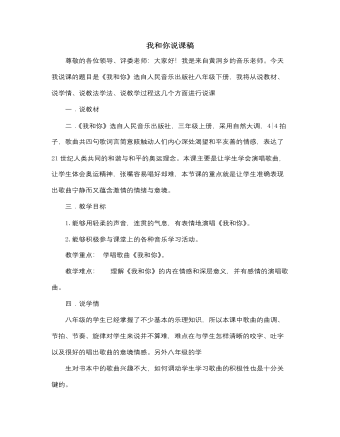
人音版小学音乐三年级上册我和你说课稿
6.欣赏第二版本。 师:关于歌曲《我和你》,还有一个鲜为人知的小故事,歌曲的原唱其实另有他人。最初作曲家陈其钢选了非常有实力的两位歌坛新秀来演唱,导演张艺谋认为一定要选择知名度很高的歌手,两人还因此大吵了一架,据说原唱的歌声更加轻盈,更加动听,你们想听一听吗?7.演唱常石磊版。 师:大家知道了,为了更好地表现出这首歌的宁静简单的气质,我们的演唱要最大限度地轻盈、柔和,就像天使的声音一样纯净。下面该轮到同学们来演唱了。注意眼睛看老师的手势,控制好气息,有表情地演唱。8.钢琴伴奏演唱。师:通过演唱,同学们肯定都感受到了这首歌曲的动人之处。下面我想请同学们站起来,想象我们来到宽敞的户外,把心放在天地间,让我们跟着钢琴伴奏,用我们纯净美妙的歌声来演绎。
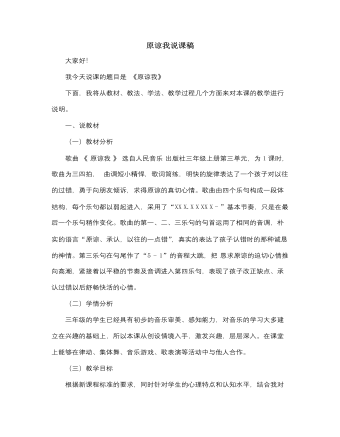
人音版小学音乐三年级上册原谅我说课稿
4)进行分组练唱、对唱、全体学生合唱。在分组练唱过程中,我将在学生中间进行单独指导,询问他们学习的难点并与学生一起解决,然后适当提问个别学生。通过小组唱、对唱等形式进行演唱评比,提高学生演唱热情。这样,不仅加深了学生对歌曲的熟悉程度,还为学生更好地理解歌曲做了铺垫。5)表演唱,通过表演,不仅展示了学生个性、激发学生的创造力、表现力,而且再次加深了学生对歌曲情感的理解和体验。(三)第三环节——拓展延伸通过对歌曲节拍节奏的改编,让学生感受到得到好朋友原谅后又能快乐的游戏的情绪变化,感受到与好朋友在一起是一件幸福快乐的事。本方案的设计,力求体现以人为本的思想,着眼于学生的主动发展,通过充分的音乐实践,培养学生的能力,提高音乐素养;培养学生的合作意识、探究精神。从目标的提出、到过程的安排、学习方法的确定、乃至学习成果的呈现,都让学生有更大的自主性、更多的实践性。
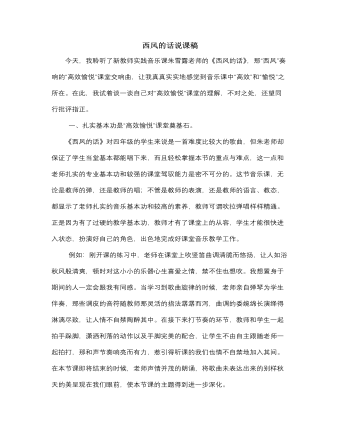
人音版小学音乐四年级下册西风的话说课稿
课堂上随机给出鼓励和肯定的语言更显教师的亲和力,营造出一个自由、民主的课堂教学氛围。如:“你很棒”“说得太好了”“掌声鼓励”等等,听似平淡无奇,但结合那时那景则显得老师语言的朴实与自然,学生同老师间的默契与和谐。听完朱老师执教的《西风的话》一课,通过认真反思我真切认识到:一堂好课是否愉悦高效,就看教师是否真正用心的地去诠释作品,真正用心地去备课。孙老师执教的《西风的话》平实、淡雅,教师教态自然大气,言谈中充满着激情,让我们的心不自觉跟着一起走。我想不出什么华丽的词藻来描述这堂课,但我却深深地被吸引,这应该就是生命课堂的魅力所在吧。听了孙老师执教的《西风的话》后收获很多,能于言表的也还没有表达充分,但更多的是带给我的触动和对自己所教学科如何“高效愉悦”的思索。也希望凭借着“高效愉悦”课堂活动的深入开展,让自己的美术课堂灵动起来,让我们的课堂真正成为孩子们探求知识的乐园。
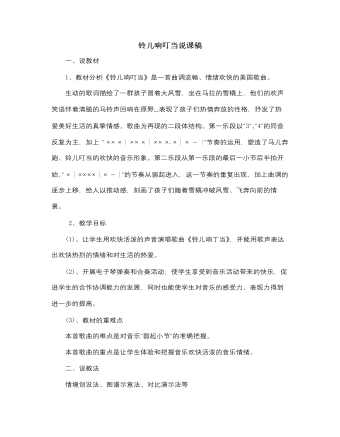
人音版小学音乐五年级下册铃儿响叮当说课稿
结合我们学校的教学条件和我自身会弹琴的优势,我还设计了课堂弹奏活动,激励学生练习好了参加圣诞联欢晚会给大家表演节目。 我把第一段的乐谱进行了简化节奏让学生弹奏,在弹奏基本完成后还设计了学生边唱边弹,并且分组让学生用电子琴自带的的打击乐器进行合奏练习,让学生在学唱的同时更加深入的体会音乐欢快活泼的节奏特点,同时让学生感受合奏的整体的音响效果,培养了学生的动手能力和集体合作能力。 六、总结 本课以歌曲《铃儿响叮当》为主要内容,听、唱、弹等教学环节都围绕他展开,各教学环节的设计易于统一,各项活动的设计均以音乐审美为核心,教学中关注段落的划分,注重引导学生的参与,体验,引导学生积极探索创造学习,展现音乐的节奏之美。
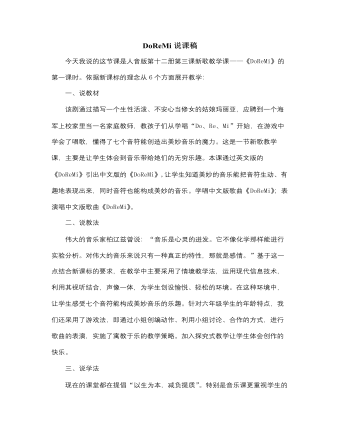
人音版小学音乐六年级下册DoReMi说课稿
1.通过欣赏《DO RE Mi》的影片,调动学生的积极性,增强学生学习新歌的兴趣。2.了解电影。任何一首歌曲都有着不一样的故事,通过文字简介,能够帮助学生深入歌曲的学习,升华表演的情绪。然后通过聆听歌曲《DO RE MI》,师范唱,生听唱,师指导唱的形式来帮助学生继续领略音乐的魅力。7.音乐游戏。不仅将学生分成七个小组跟琴演唱,还让学生根据伴奏完成歌曲接龙,充分体现了学生在课堂中的主体性。8.拓展开发。通过了解柯尔文手势,电影的背景资料和歌曲《孤独的牧羊人》的欣赏,提高学生的能力。第二环节既是这节课的重点,也是难点,通过引导学生运用手势音阶和肢体语言来表演歌曲《DoReMi》,又通过小组合作的方式突破难点。最后小结,简单地总结了同学们的表演让所有人感受到音乐带给我们的无穷乐趣,七个音乐字母构成了美妙的音乐,最后在美妙的音乐中结束了这节课!
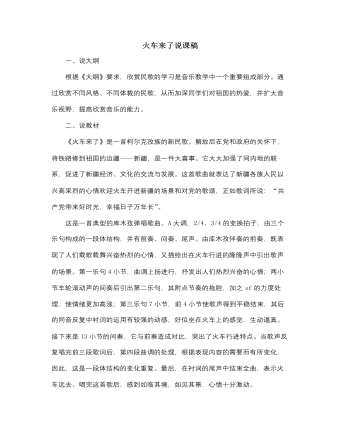
人音版小学音乐六年级下册火车来了说课稿
1、视觉图象法:少数民族的风土人情对我们汉族的孩子来说不那么了解。为了使他们更直接地了解到新疆柯尔克孜族人们的生活习惯,我运用电脑软件制作了一些柯尔克孜族的风情画面,给学生视听结合,避免枯燥的说教形式,使本来抽象的 内容变得具体形象化。2、对比欣赏法:在了解这个民族的风土人情时,我运用画面表格形式将新疆几个民族的人物作对比,从而使学生更清楚的了解这个民族的风土人情、歌曲特点。在教学中我还运用了创设情景、兴趣引入法、感性到理性等方法 。音乐家修海林认为“音乐审美必须要求体验到音乐的意境”,在这一课,我充分运用了多媒体教学手段,尽量让学生体验到音乐的意境,从屏幕上看到新疆的风土人情关系,听到新疆民歌不同的风格特点。
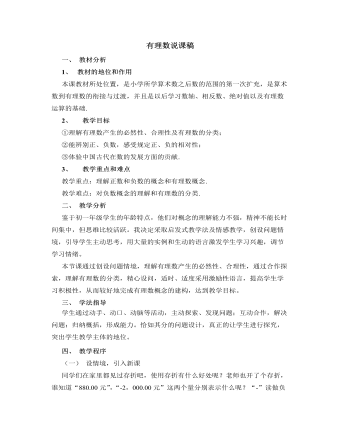
北师大初中数学七年级上册有理数说课稿
1、 教材的地位和作用本课教材所处位置,是小学所学算术数之后数的范围的第一次扩充,是算术数到有理数的衔接与过渡,并且是以后学习数轴、相反数、绝对值以及有理数运算的基础.2、 教学目标①理解有理数产生的必然性、合理性及有理数的分类;②能辨别正、负数,感受规定正、负的相对性;③体验中国古代在数的发展方面的贡献.3、 教学重点和难点教学重点:理解正数和负数的概念和有理数概念.教学难点:对负数概念的理解和有理数的分类.二、 教学分析鉴于初一年级学生的年龄特点,他们对概念的理解能力不强,精神不能长时间集中,但思维比较活跃。我决定采取启发式教学法及情感教学,创设问题情境,引导学生主动思考,用大量的实例和生动的语言激发学生学习兴趣,调节学习情绪。
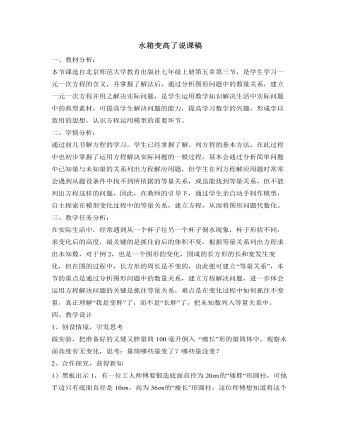
北师大初中数学七年级上册水箱变高了说课稿
一、教材分析:本节课选自北京师范大学教育出版社七年级上册第五章第三节,是学生学习一元一次方程的含义,并掌握了解法后,通过分析图形问题中的数量关系,建立一元一次方程并用之解决实际问题,是学生运用数学知识解决生活中实际问题中的典型素材,可提高学生解决问题的能力,提高学习数学的兴趣,形成学以致用的思想,认识方程运用模型的重要环节。二、学情分析:通过前几节解方程的学习,学生已经掌握了解、列方程的基本方法,在此过程中也初步掌握了运用方程解决实际问题的一般过程,基本会通过分析简单问题中已知量与未知量的关系列出方程解应用题,但学生在列方程解应用题时常常会遇到从题设条件中找不到所依据的等量关系,或虽能找到等量关系,但不能列出方程这样的问题,因此,在教师的引导下,通过学生亲自动手制作模型,自主探索在模型变化过程中的等量关系,建立方程,从而将图形问题代数化。
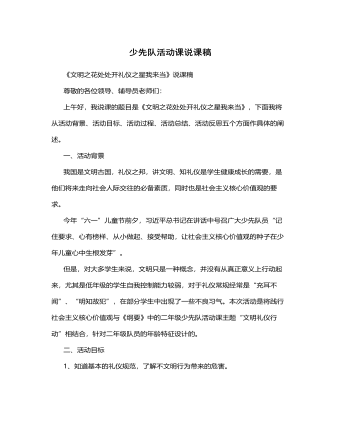
文明之花处处开,礼仪之星我来当说课稿(1)
四、活动总结及反思本次活动,让学生变身“小小侦查员”,调动他们观察发现的积极性,认识到生活中哪些行为是不文明的。运用“新闻直播间”这一新颖的形式,学生在认真聆听讨论之余,知道小小的不文明行为也会造成严重后果。继而通过“情绪体验岛”,引导孩子们在情绪不好的时候,学会自我调整情绪,及时避免不文明行为。最后及时表彰,鼓励其他队员以他们为榜样,使活动主题得以升华。在这一系列充满童趣,层层深入的活动中,同学们表现出了很高的积极性,平时的一言一行都有意识地按文明礼仪的要求做,班风也有了进一步提高。在充分肯定成绩的同时,我们也认识到,不仅要常常开展校园文明礼仪活动,还要开展家庭文明礼仪活动及社会文明礼仪活动,让文明礼仪之花不仅在学校开放,还要开放到家庭、开放到社会,营造出一片人人都讲文明知礼仪的氛围。

文明之花处处开,礼仪之星我来当说课稿(2)
本次活动,让学生变身“小小侦查员”,调动他们观察发现的积极性,认识到生活中哪些行为是不文明的。运用“新闻直播间”这一新颖的形式,学生在认真聆听讨论之余,知道小小的不文明行为也会造成严重后果。继而通过“情绪体验岛”,引导孩子们在情绪不好的时候,学会自我调整情绪,及时避免不文明行为。最后及时表彰,鼓励其他队员以他们为榜样,使活动主题得以升华。在这一系列充满童趣,层层深入的活动中,同学们表现出了很高的积极性,平时的一言一行都有意识地按文明礼仪的要求做,班风也有了进一步提高。在充分肯定成绩的同时,我们也认识到,不仅要常常开展校园文明礼仪活动,还要开展家庭文明礼仪活动及社会文明礼仪活动,让文明礼仪之花不仅在学校开放,还要开放到家庭、开放到社会,营造出一片人人都讲文明知礼仪的氛围。
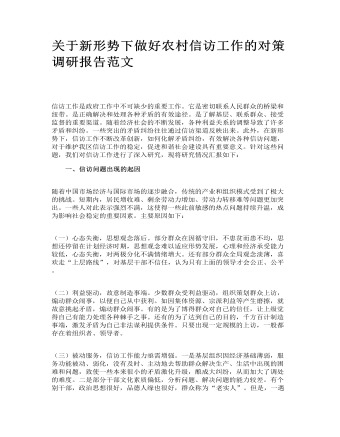
关于新形势下做好农村信访工作的对策调研报告范文
(一)心态失衡,思想观念落后。部分群众在因循守旧,不患贫而患不均,思想还停留在计划经济时期,思想观念难以适应形势发展,心理和经济承受能力较低,心态失衡,对两极分化不满情绪增大。还有部分群众全局观念淡薄,喜欢走“上层路线”,对基层干部不信任,认为只有上面的领导才会公正、公平。 (二)利益驱动,故意制造事端。少数群众受利益驱动,组织策划群众上访,煽动群众闹事,以便自己从中获利。如因集体资源、宗派利益等产生磨擦,就故意挑起矛盾,煽动群众闹事。有的是为了博得群众对自己的信任,让上级觉得自己有能力处理各种棘手之事。还有的为了达到自己的目的,千方百计制造事端,激发矛盾为自己非法谋利提供条件。只要出现一定规模的上访,一般都存在着组织者、领导者。
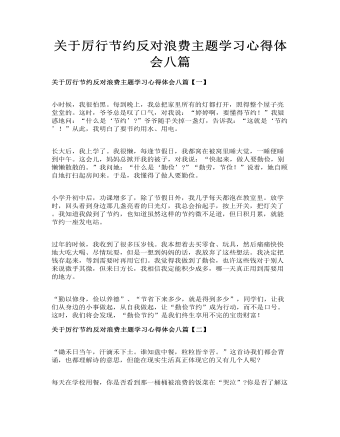
关于厉行节约反对浪费主题学习心得体会八篇
“锄禾日当午,汗滴禾下土。谁知盘中餐,粒粒皆辛苦。”这首诗我们都会背诵,也都理解诗的意思,但能在现实生活真正体现它的又有几个人呢? 每天在学校用餐,你是否看到那一桶桶被浪费的饭菜在“哭泣”?你是否了解这是多少农民伯伯辛勤的汗水换来的?你是否知道还有很多人在为家人的温饱而奔波劳累?你是否知道还有很多人在温饱线上苦苦挣扎?
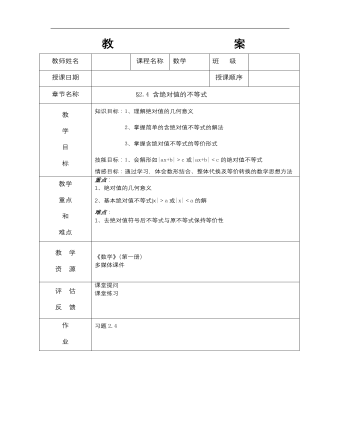
【高教版】中职数学基础模块上册:2.4《含绝对值的不等式》教案设计
教师姓名 课程名称数学班 级 授课日期 授课顺序 章节名称§2.4 含绝对值的不等式教 学 目 标知识目标:1、理解绝对值的几何意义 2、掌握简单的含绝对值不等式的解法 3、掌握含绝对值不等式的等价形式 技能目标:1、会解形如|ax+b|>c或|ax+b|<c的绝对值不等式 情感目标:通过学习,体会数形结合、整体代换及等价转换的数学思想方法教学 重点 和 难点重点: 1、绝对值的几何意义 2、基本绝对值不等式|x|>a或|x|<a的解 难点: 1、去绝对值符号后不等式与原不等式保持等价性教 学 资 源《数学》(第一册) 多媒体课件评 估 反 馈课堂提问 课堂练习作 业习题2.4课后记不等式的基本性质是初中就学习过的内容,分式不等式的解法是哦本节课的一个重点和难点,尤其是不等号另一边不为0的情况,需要移项,这一点在强调前学生考虑不到,因此解题错误多。区间是个新内容,学生往往将连续的正数写作一个区间,这是常见的错误,要进行提醒。另外,在均值不等式这里稍微补充了一些内容,引起学生的兴趣。
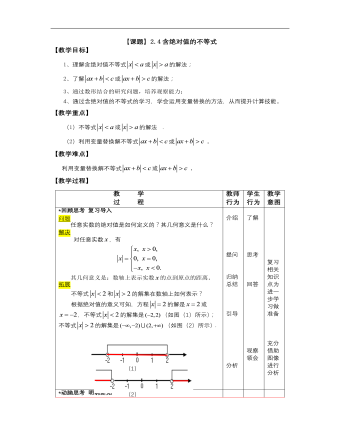
【高教版】中职数学基础模块上册:2.4《含绝对值的不等式》优秀教案
【教学目标】1、理解含绝对值不等式或的解法;2、了解或的解法;3、通过数形结合的研究问题,培养观察能力;4、通过含绝对值的不等式的学习,学会运用变量替换的方法,从而提升计算技能。【教学重点】(1)不等式或的解法.(2)利用变量替换解不等式或.【教学难点】 利用变量替换解不等式或.【教学过程】 教 学 过 程教师 行为学生 行为教学 意图 *回顾思考 复习导入 问题 任意实数的绝对值是如何定义的?其几何意义是什么? 解决 对任意实数,有 其几何意义是:数轴上表示实数的点到原点的距离. 拓展 不等式和的解集在数轴上如何表示? 根据绝对值的意义可知,方程的解是或,不等式的解集是(如图(1)所示);不等式的解集是(如图(2)所示). 介绍 提问 归纳总结 引导 分析 了解 思考 回答 观察 领会 复习 相关 知识 点为 进一 步学 习做 准备 充分 借助 图像 进行 分析
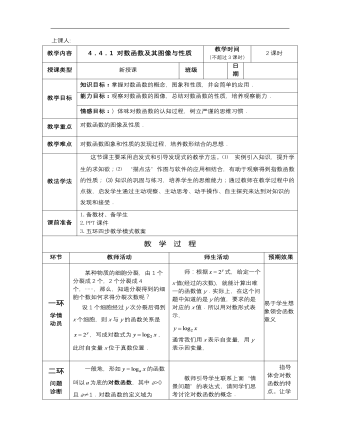
【高教版】中职数学基础模块上册:4.4《对数函数》优秀教案
教学内容4.4.1 对数函数及其图像与性质教学时间 (不超过3课时)2课时授课类型新授课班级 日期 教学目标知识目标:掌握对数函数的概念,图象和性质,并会简单的应用.能力目标:观察对数函数的图像,总结对数函数的性质,培养观察能力.情感目标:)体味对数函数的认知过程,树立严谨的思维习惯.教学重点对数函数的图像及性质.教学难点对数函数图象和性质的发现过程,培养数形结合的思想.教法学法这节课主要采用启发式和引导发现式的教学方法。⑴ 实例引入知识,提升学生的求知欲;⑵ “描点法”作图与软件的应用相结合,有助于观察得到指数函数的性质; ⑶知识的巩固与练习,培养学生的思维能力;通过教师在教学过程中的点拨,启发学生通过主动观察、主动思考、动手操作、自主探究来达到对知识的发现和接受.课前准备1.备教材、备学生 2.PPT课件 3.五环四步教学模式教案教 学 过 程环节教师活动师生活动预期效果一环 学情 动员某种物质的细胞分裂,由1个分裂成2个,2个分裂成4个,……,那么,知道分裂得到的细胞个数如何求得分裂次数呢? 设1个细胞经过y次分裂后得到x个细胞,则x与y的函数关系是,写成对数式为,此时自变量x位于真数位置.师:根据式,给定一个x值(经过的次数),就能计算出唯一的函数值y.实际上,在这个问题中知道的是y的值,要求的是对应的x值.所以用对数形式表示, 通常我们用x表示自变量,用y表示因变量, 易于学生想象领会函数意义二环问题 诊断一般地,形如的函数叫以为底的对数函数,其中a>0且a≠1.对数函数的定义域为,值域为R. 例如、、都是对数函数. 教师引导学生联系上面“情景问题”的表达式,请同学们思考讨论对数函数的概念. 师:(1) 为什么规定 a>0且 a≠1? (2) 为什么对数函数的定义域是(0,+∞)? 指导体会对数函数的特点。让学生牢记底数大于零且不等于1,真数大于零.
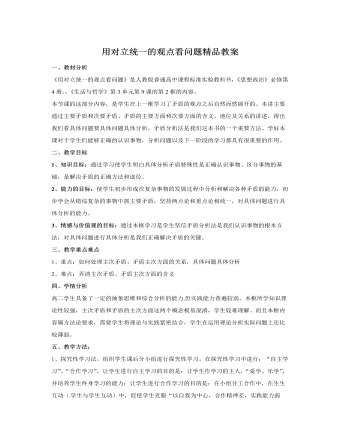
人教版高中政治必修4用对立统一的观点看问题精品教案
1、重点:如何处理主次矛盾、矛盾主次方面的关系,具体问题具体分析2、难点:弄清主次矛盾、矛盾主次方面的含义四、学情分析高二学生具备了一定的抽象思维和综合分析的能力,但实践能力普遍较弱。本框所学知识理论性较强,主次矛盾和矛盾的主次方面这两个概念极易混淆,学生较难理解。而且本框内容属方法论要求,需要学生将理论与实践紧密结合,学生在运用理论分析实际问题上还比较薄弱。五、教学方法:1、探究性学习法。组织学生课后分小组进行探究性学习。在探究性学习中进行:“自主学习”、“合作学习”。让学生进行自主学习的目的是:让学生作学习的主人,“爱学、乐学”,并培养学生终身学习的能力;让学生进行合作学习的目的是:在小组分工合作中,在生生互动( 学生与学生互动)中,促使学生克服“以自我为中心,合作精神差,实践能力弱“等不足,培养综合素质。2、理论联系实际法。关注生活,理论联系实际,学以致用。
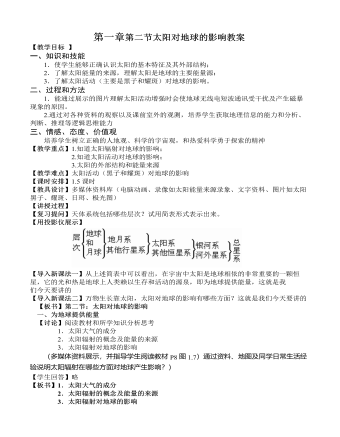
人教版高中地理必修1第一章第二节太阳对地球的影响教案
一、知识和技能1.使学生能够正确认识太阳的基本特征及其外部结构;2.了解太阳能量的来源,理解太阳是地球的主要能量源;3.了解太阳活动(主要是黑子和耀斑)对地球的影响。二、过程和方法1.能通过展示的图片理解太阳活动增强时会使地球无线电短波通讯受干扰及产生磁暴现象的原因。2.通过对各种资料的观察以及课前室外的观测,培养学生获取地理信息的能力和分析、判断、推理等逻辑思维能力三、情感、态度、价值观培养学生树立正确的人地观、科学的宇宙观,和热爱科学勇于探索的精神【教学重点】1.知道太阳辐射对地球的影响; 2.知道太阳活动对地球的影响;3.太阳的外部结构和能量来源【教学难点】太阳活动(黑子和耀斑)对地球的影响
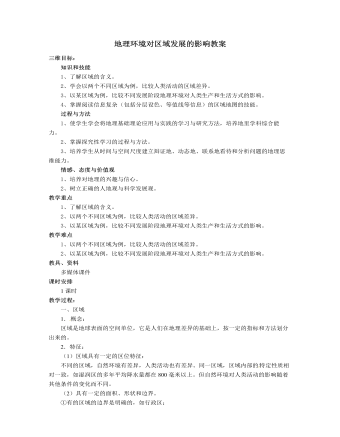
人教版高中地理必修3地理环境对区域发展的影响教案
(1)下面列出的是我国南北方传统民居的差异,分析形成这些差异的自然原因:——北方民居正南正北的方位观比南方强;——北方民居的墙体严实厚重,南方民居的墙体轻薄;——从北到南,民居的屋顶坡度逐渐增大,房檐逐渐加宽,房屋进深和高度逐渐加大。(2)下面列出的是我国南北方城市住宅搂的差异,分析导致这些差异的自然原因:——如果不考虑地价、建筑材料等因素,建同等面积的住房,北方的建筑成本比南方高 ;——建同样高度的多幢楼房,北方楼房的南北间距比南方大。点拨:本活动要求学生了解由于地理环境的差异造成南北方建筑物特点的不同,并由此认识地理环境 差异对人们生活的影响。(1)比较而言,北方的冬季寒冷而漫长,南方的夏季湿热而漫长。为了在冬季充分利用太阳光照和热量,北方民居正南正北的方位观比南方强。北方民居的墙体严实厚重,利用在冬季保温御寒;南方民居的墙体轻薄,利于在夏季通风透气。从北到南,年降水量逐渐增大,民居的屋顶坡度也逐渐增大(利于排水) ;随着对保温要求的降低和对通风纳凉要求的提高,民居的屋檐逐渐加宽,房屋进深和高度逐渐加大。
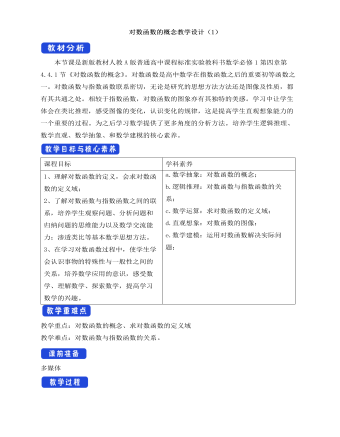
人教A版高中数学必修一对数函数的概念教学设计(1)
本节课是新版教材人教A版普通高中课程标准实验教科书数学必修1第四章第4.4.1节《对数函数的概念》。对数函数是高中数学在指数函数之后的重要初等函数之一。对数函数与指数函数联系密切,无论是研究的思想方法方法还是图像及性质,都有其共通之处。相较于指数函数,对数函数的图象亦有其独特的美感。学习中让学生体会在类比推理,感受图像的变化,认识变化的规律,这是提高学生直观想象能力的一个重要的过程。为之后学习数学提供了更多角度的分析方法。培养学生逻辑推理、数学直观、数学抽象、和数学建模的核心素养。1、理解对数函数的定义,会求对数函数的定义域;2、了解对数函数与指数函数之间的联系,培养学生观察问题、分析问题和归纳问题的思维能力以及数学交流能力;渗透类比等基本数学思想方法。3、在学习对数函数过程中,使学生学会认识事物的特殊性与一般性之间的关系,培养数学应用的意识,感受数学、理解数学、探索数学,提高学习数学的兴趣。
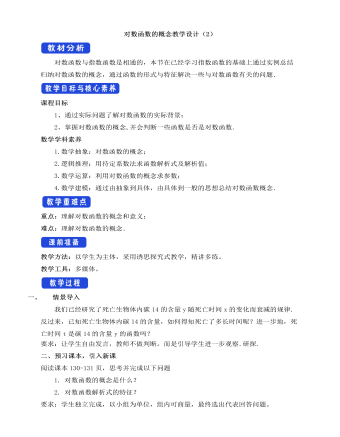
人教A版高中数学必修一对数函数的概念教学设计(2)
对数函数与指数函数是相通的,本节在已经学习指数函数的基础上通过实例总结归纳对数函数的概念,通过函数的形式与特征解决一些与对数函数有关的问题.课程目标1、通过实际问题了解对数函数的实际背景;2、掌握对数函数的概念,并会判断一些函数是否是对数函数. 数学学科素养1.数学抽象:对数函数的概念;2.逻辑推理:用待定系数法求函数解析式及解析值;3.数学运算:利用对数函数的概念求参数;4.数学建模:通过由抽象到具体,由具体到一般的思想总结对数函数概念.重点:理解对数函数的概念和意义;难点:理解对数函数的概念.教学方法:以学生为主体,采用诱思探究式教学,精讲多练。教学工具:多媒体。一、 情景导入我们已经研究了死亡生物体内碳14的含量y随死亡时间x的变化而衰减的规律.反过来,已知死亡生物体内碳14的含量,如何得知死亡了多长时间呢?进一步地,死亡时间t是碳14的含量y的函数吗?



